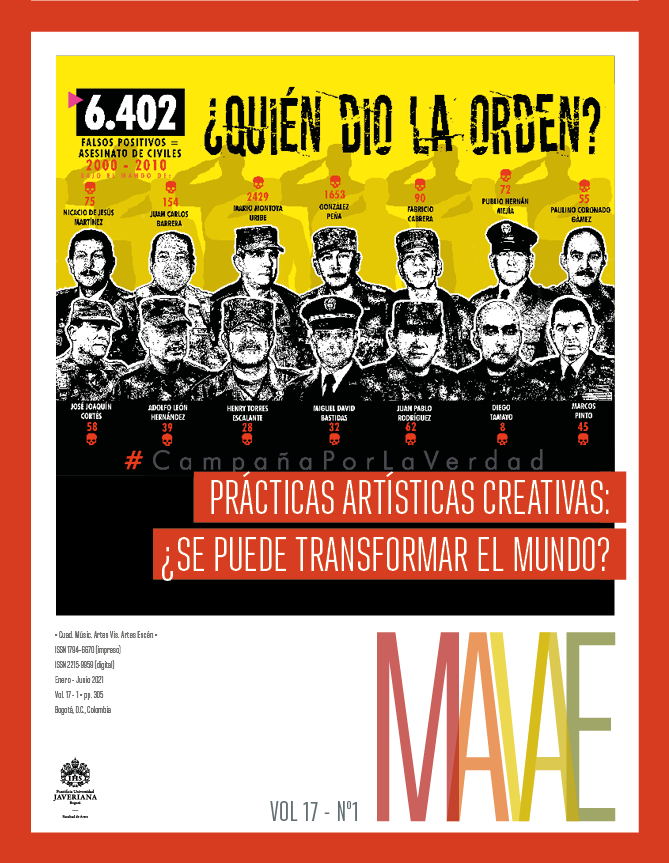Resumen
Durante las manifestaciones de 2019 llevadas a cabo en Ecuador, Perú, Colombia y Chile, la música estuvo llena de contenido político y poético como canto común, símbolo de resistencia, confrontación y lucha. Este artículo tiene como objetivo problematizar el uso que tuvo la música en la revuelta social en Chile de 2019. Para ello, se toman los conceptos de acción política, poética política y teatro político, así como la protesta urbana y las estrategias de enfrentamiento entre el colectivo y el Estado. Metodológicamente, se realiza el estudio de tres casos a partir de la netnografía, el análisis intratextual y las metanarrativas entre los parámetros musicales y audiovisuales en la videoprotesta. Se ha evidenciado la resignificación de músicas populares: la cumbia como elemento ritual en las calles, la canción El baile de los que sobran de Los Prisioneros como recurso y estrategia de la memoria y, por último, el videoclip Plata ta tá de Mon Laferte como herramienta de protesta en el circuito de consumo comercial. Como conclusión, se ha establecido que el vínculo entre música y resistencia deviene el accionar simbólico del arte y la política en la ciudadanía, que deroga y exige cambios en un modelo político imperante.
Array Argel, Rodrigo. 2020. “Los Prisioneros: entre la New Wave y la Nueva Ola”. Contrapulso. Revista Latinoamericana de Estudios en Música Popular. Vol. 2, N° 1, pp. 49-63.
Baker, Geoffrey. 2014. El Sistema. Orchestrating Venezuela’s Youth. Nueva York: Oxford University Press.
Baker, Sarah; Andy Bennett y Jodie Taylor. 2013. Redefining Mainstream Popular Music. Nueva York: Routledge.
Barthes Roland. 1986. El grano de voz. Barcelona: Paidós.
Bieletto Bueno, Natalia y Christian Spencer. 2020. “Volver a crecer. Crisis social, música, sonido y escucha en la revuelta chilena (2019-2020)”. En Boletín de Música. Revista de música latinoamericana y caribeña, 54: 3-27.
Brandtstadter, Susane. 2015. Falsificaciones, derechos y protestas. México: Fondo de Cultura Económica.
Colapietro, Vincent M. y Thomas M.Olshewsky. 1996. Peirce’s Doctrine of Signs. Theory, Applications, and Connections. Berlín: Mouton de Gruyter.
Colectiva de investigación Tiesos pero Cumbiancheros. 2019. “Cumbia ‘a la chilena’: una mirada desde el cuerpo”. En El libro de la Cumbia: Resonancias, transferencias y trasplantes de las cumbias latinoamericanas, 239-272. Medellín: Instituto Tecnológico Metropolitano y Discos Fuentes S.A.
Elias, Norbert y John L. Scotson. 2016. Establecidos y marginados. Una investigación sociológica sobre problemas comunitarios. México: Fondo de Cultura Económica.
Fugellie, Daniela. 2020. “Resignificando el canon: el Requiem de Mozart en el estallido social chileno”. Boletín de Música. Revista de música latinoamericana y caribeña, 54: 93-110.
González, Juan Pablo. 2020. “Editorial”. Contrapulso. Revista latinoamericana de estudios en música popular 2, 2:1-2. https://contrapulso.uahurtado.cl/index.php/cp
Herzfeld, Michael. 2005. Cultural Intimacy. Social Poetics in the Nation-State. Londres: Routledge.
Holston, James. 2008. Insurgent Citizenship: Disjunctions of Democracy and Modernity in Brazil. Princeton: University Press.
Kozinets, Robert V. 2015. Netnography: Redefined. Los Angeles: SAGE.
Kutschkle, Beate y Barley Norton. 2013. Music and Protest in 1968. Cambridge: Universidad de Cambridge.
Marchant, Oliver. 2013. “Dancing Politics. Political Reflections on Choreography, Dance and Protest”. En Dance, Politics & Co-Immunity. Thinking Resistances. Current Perspectives on Politics and Communities in the Arts. Vol. 1. Zurich-Berlín: Diaphanes: 39-57.
Massone, Manuel; Mario Celentano y Mariano De Filippis. 2019. “‘Las palmas de todos los negros arriba’. Origen, influencia y análisis musical de la cumbia villera”. En El libro de la Cumbia: Resonancias, transferencias y trasplantes de las cumbias latinoamericanas, 297-349. Medellín: Instituto Tecnológico Metropolitano y Discos Fuentes S.A.
Palacios, Mariantonia. 2020. “Venezuela: el sonido de la protesta”. Instituto Tecnológico Metropolitano, Medellín. XIV Congreso de la IASPM-AL.
Parra Valencia, Juan Diego. 2019a. Deconstruyendo el chucu-chucu. Auges, declives y resurrecciones de la música tropical colombiana. Medellín: Instituto Tecnológico Metropolitano.
Parra Valencia, Juan Diego (recopilador). 2019b. El libro de la Cumbia: Resonancias, transferencias y trasplantes de las cumbias latinoamericanas. Medellín: Instituto Tecnológico Metropolitano y Discos Fuentes S.A.
Peddie, Ian. 2017. The Resisting Music: Popular Music anda Social Protest. Londres: Ashgate.
Rosenstone, Robert A. 1969. “The Times They Are A-Changin: The Music of Protest”. En The Annals of the American Academy of Political and Social Science 382, 1.
Salkosky, Ronald y Fred Wei-Han Ho (editores). 1995. Sounding Off! Music as Subversion/ Resistance/Revolution. New York: Autonomedia.
Silva Marra, Pedro y Ana Beatríz Moreto. 2020. “Sonoridades del protestos feministas e de visibilidad lésbica no Brazil”. Instituto Tecnológico Metropolitano, Medellín. XIV Congreso de la IASPM-AL.
Spencer, Christian. 2020a. “Con todo sino pá qué: música, baile y resistencia en la revuelta social chilena, el caso de Plata ta tá de Mon Laferte”. Instituto Tecnológico Metropolitano, Medellín. XIV Congreso de la IASPM-AL.
Spencer, Christian. 2020b. “Hacia un nuevo cancionero popular: música, creación y política en la revuelta social chilena (2019-2020)”. En Boletín de Música. Revista de música latinoamericana y caribeña, 54: 29-52.
Thompson, Edward P. 2000. Agenda para una historia radical. Barcelona: Crítica.
Zagorski-Thomas, Simon. 2014. The Musicology of Record Production. Cambridge: Cambridge University Press.
Grabación imagen
Bunny, Bad y Residente. 2019. “Desahogo”. Dirigido por Ricardo Duars. Video en YouTube. https://www.youtube.com/watch?v=dbB_gTIhFDU
Chela, La Mambo. 2019. “Chile Despertó”. Video en YouTube. https://www.youtube.com/watch?v=jLcenJZl7EQ
Laferte, Mon y Guaynaa. 2019. “Plata ta tá”. Dirigido por The Producers. Video en YouTube. https://www.youtube.com/watch?v=tAcJhezQz7E
Negra, Alma. 2019 “Chile 11/12/2019 primera línea también baila pacos ctm”. Video en YouTube. Chile 11/12/2019 primera línea también baila pacos ctm
Grabación sonido
Jiménez, José Alfredo. 1971. “ El Rey”, en Sigo siendo el rey. Vinilo. Ciudad de México. BMG México.

Esta obra está bajo una licencia internacional Creative Commons Atribución 4.0.
Derechos de autor 2021 Luis Ramon Perez Valero


